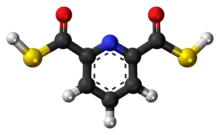2,6-Pyridinedicarbothioic acid
2,6-Pyridinedicarbothioic acid (PDTC) is an organosulfur compound that is produced by some bacteria. It functions as a siderophore, a small chelating agent with a high affinity for iron. Siderophores are deployed as ion scavengers for microbes. Siderophores solubilize compounds by forming strong complexes. PDTC is secreted by the soil bacteria Pseudomonas stutzeri and Pseudomonas putida.[1]
 | |
 | |
| Names | |
|---|---|
| IUPAC name
2,6-Pyridinedicarbothioic acid | |
| Preferred IUPAC name
Pyridine-2,6-bis(carbothioic S-acid) | |
| Other names
PDTC, dithiopyridinedicarbothioic acid | |
| Identifiers | |
3D model (JSmol) |
|
| ChemSpider | |
PubChem CID |
|
| UNII | |
CompTox Dashboard (EPA) |
|
| |
| |
| Properties | |
| C7H5O2S2 | |
| Molar mass | 185.24 g·mol−1 |
| Appearance | White crystalline solid |
| Density | 1.415 g/cm3 |
| Melting point | 97 to 99 °C (207 to 210 °F; 370 to 372 K) |
| Boiling point | 404.4 °C (759.9 °F; 677.5 K) |
| 1000 g/L (5.02 mol/L) | |
| Hazards | |
| Occupational safety and health (OHS/OSH): | |
Main hazards |
acidic |
| Flash point | 198.4 °C (389.1 °F; 471.5 K) |
Except where otherwise noted, data are given for materials in their standard state (at 25 °C [77 °F], 100 kPa).
Infobox references | |
Synthesis and biosynthesis
PDTC can be synthesized by treating the pyridine-2,6-dicarboxylic acid (or its diacid dichloride) with H2S in dry pyridine:
- NC5H3(COOH)2 + 2 H2S → NC5H3(COSH)2 + 2 H2O
This produces an orange 1:1 pyridinium salt of 2,6-pyridinedicarbothioate. Treatment of this salt with acid give PDTC, which can then be extracted with dichloromethane.
The biosynthesis of PDTC remains unclear although some insights can be deduced from the genetics.[2] It is suggested that Pseudomonas stutzeri may have acquired at least one of the genes by lateral transfer from mycobacteria.[3] In a proposed biosynthetic sequence pyridine-2,6-dicarboxylic acid, a known bacterial metabolite,[3] is activated as its bis-adenosine monophosphate (AMP) derivative. The sulfur donor and its activation remain uncertain.[4]
Coordination chemistry
PDTC binds to both Fe2+ and Fe3+. The ferric complex is brown, whereas the ferrous complex is blue. In the presence of air, the ferrous complex oxidizes to the ferric compound.[5] It is iron selective[3] as only the Fe complex is soluble in water. PDTC is produced mainly during the exponential phase of bacterial growth. The conditions at which Pseudomonas produces PDTC is 25 °C, pH=8 and sufficient aeration.[4]
See also
References
- Budzikiewicz, Herbert (2010). "Microbial Siderophores". In Kinghorn, A. Douglas; Falk, Heinz; Kobayashi, Junichi (eds.). Fortschritte der Chemie organischer Naturstoffe [Progress in the Chemistry of Organic Natural Products]. Fortschritte der Chemie organischer Naturstoffe / Progress in the Chemistry of Organic Natural Products. Vol. 92. pp. 1–75. doi:10.1007/978-3-211-99661-4_1. ISBN 978-3-211-99660-7. PMID 20198464.
- Cortese, Marc S; Caplan, Allan B; Crawford, Ronald L (2002). "Structural, functional, and evolutionary analysis of moeZ, a gene encoding an enzyme required for the synthesis of the Pseudomonas metabolite, pyridine-2,6-bis(thiocarboxylic acid)". BMC Evolutionary Biology. 2: 8. doi:10.1186/1471-2148-2-8. PMC 115864. PMID 11972321.
- Cortese, Marc S.; Paszczynski, Andrzej; Lewis, Thomas A.; Sebat, Jonathan L.; Borek, Vladimir; Crawford, Ronald L. (2002). "Metal chelating properties of pyridine-2,6-bis(thiocarboxylic acid) produced by Pseudomonas spp. And the biological activities of the formed complexes". BioMetals. 15 (2): 103–120. doi:10.1023/A:1015241925322. PMID 12046919. S2CID 5545637.
- Budzikiewicz, H. (2003). "Heteroaromatic monothiocarboxylic acids from Pseudomonas spp". Biodegradation. 14 (2): 65–72. doi:10.1023/A:1024012015127. PMID 12877462. S2CID 29898226.
- Ockels, W., Roemer, A., Budzikiewicz, H., Korth, H., Pulverer, G., "Bacterial constituents. II. An iron(II) complex of pyridine-2,6-di-(monothiocarboxylic acid) - a novel bacterial metabolic product", Tetrahedron Lett. 1978, 3341. doi:10.1016/S0040-4039(01)85634-3